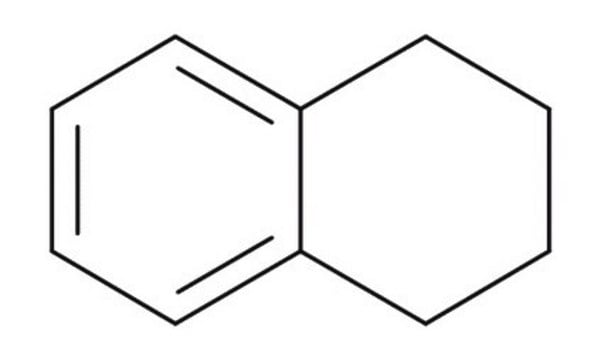456438
1,2,3,4-Tetrahydronaphthalene
reagent grade, ≥97%
Synonyme(s) :
Tétraline solvant
About This Item
Produits recommandés
Qualité
reagent grade
Niveau de qualité
Densité de vapeur
4.55 (vs air)
Pression de vapeur
0.18 mmHg ( 20 °C)
Pureté
≥97%
Forme
liquid
Température d'inflammation spontanée
723 °F
Limite d'explosivité
0.8 %, 100 °F
5 %, 150 °F
Indice de réfraction
n20/D 1.541 (lit.)
Point d'ébullition
207 °C (lit.)
Pf
−35 °C (lit.)
Densité
0.973 g/mL at 25 °C (lit.)
Chaîne SMILES
C1CCc2ccccc2C1
InChI
1S/C10H12/c1-2-6-10-8-4-3-7-9(10)5-1/h1-2,5-6H,3-4,7-8H2
Clé InChI
CXWXQJXEFPUFDZ-UHFFFAOYSA-N
Vous recherchez des produits similaires ? Visite Guide de comparaison des produits
Description générale
Application
- Hydrogen-donor solvent in the decarboxylation of oleic acid to produce diesel fuel hydrocarbons.
- Hydrogen source for the hydrogenation of lignin-derived phenolic compounds.
Informations légales
Mention d'avertissement
Danger
Mentions de danger
Conseils de prudence
Classification des risques
Aquatic Chronic 2 - Asp. Tox. 1 - Carc. 2 - Eye Irrit. 2 - Skin Irrit. 2
Risques supp
Code de la classe de stockage
10 - Combustible liquids
Classe de danger pour l'eau (WGK)
WGK 2
Point d'éclair (°F)
159.8 °F - closed cup
Point d'éclair (°C)
71 °C - closed cup
Certificats d'analyse (COA)
Recherchez un Certificats d'analyse (COA) en saisissant le numéro de lot du produit. Les numéros de lot figurent sur l'étiquette du produit après les mots "Lot" ou "Batch".
Déjà en possession de ce produit ?
Retrouvez la documentation relative aux produits que vous avez récemment achetés dans la Bibliothèque de documents.
Notre équipe de scientifiques dispose d'une expérience dans tous les secteurs de la recherche, notamment en sciences de la vie, science des matériaux, synthèse chimique, chromatographie, analyse et dans de nombreux autres domaines..
Contacter notre Service technique









